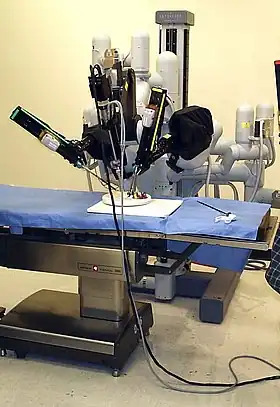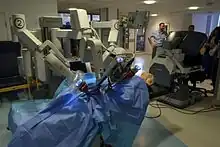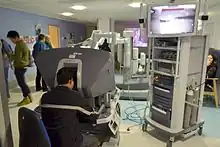Da Vinci Surgical System
 Da Vinci Surgical System | |
| Manufacturer | Intuitive Surgical |
|---|---|
| Country | United States |
| Year of creation | 2000 (initial FDA clearance) |
| Type | Medical |
| Purpose | Medical |
The da Vinci Surgical System is a robotic surgical system made by the American company Intuitive Surgical. Approved by the Food and Drug Administration (FDA) in 2000, it is designed to facilitate surgery using a minimally invasive approach, and is controlled by a surgeon from a console. The system is used for prostatectomies, and increasingly for cardiac valve repair and gynecologic surgical procedures.[1][2] According to the manufacturer, the da Vinci System is called "da Vinci" in part because Leonardo da Vinci's "study of human anatomy eventually led to the design of the first known robot in history."[3]
Da Vinci Surgical Systems were used in an estimated 200,000 surgeries in 2012, most commonly for hysterectomies and prostate removals.[4] In 2019–2020, there was an installed base of 4,986 units worldwide – 2,770 in the United States, 719 in Europe, 561 in Asia, and 221 in the rest of the world.[5] The "Si" version of the system costs on average slightly under US$2 million, in addition to about 180,000 dollars of annual maintenance fees.[6]
Medical uses
While the use of robotic surgery has become an item in the advertisement of medical services, there is a lack of studies that indicated long-term results are superior to results following laparoscopic surgery.[7]
The da Vinci System has been used in the following procedures:
- Radical prostatectomy, pyeloplasty, cystectomy, nephrectomy and ureteral reimplantation;
- Hysterectomy, myomectomy and sacrocolpopexy;
- Hiatal hernia and inguinal hernia repair;
- GI surgeries including resections and cholecystectomy;
- Transoral robotic surgery (TORS) for head and neck cancer (FDA-approved since 2009)
Device


The da Vinci System consists of a surgeon's console that is typically in the same room as the patient, and a patient-side cart with three to four interactive robotic arms (depending on the model) controlled from the console. The arms are for tools that hold objects, and can also act as scalpels, scissors, bovies, or graspers; the final arm controls the 3-D cameras.[8] The surgeon uses the console's controls to maneuver the patient-side cart's three or four robotic arms. The da Vinci System always requires a human operator.
FDA clearance
The Food and Drug Administration (FDA) cleared the da Vinci Surgical System in 2000 for adult and pediatric use in urologic surgical procedures, general laparoscopic surgical procedures, gynecologic laparoscopic surgical procedures, general non-cardiovascular thoracoscopic surgical procedures, and thoracoscopically assisted cardiotomy procedures. The FDA also cleared the da Vinci System to be employed with adjunctive mediastinotomy to perform coronary anastomosis during cardiac revascularization.
Criticism
Critics of robotic surgery assert that it is difficult for users to learn.[2] The da Vinci system uses proprietary software, which cannot be modified by physicians, thereby limiting the freedom to modify the operating system.[4] Furthermore, its $2 million cost places it beyond the reach of many institutions.[6]
The manufacturer of the system, Intuitive Surgical, has been criticized for short-cutting FDA approval by a process known as "premarket notification," and instead of entering the market through the 510(k) process. Intuitive has also been accused of providing inadequate training and encouraging health care providers to reduce the number of supervised procedures required before a doctor is allowed to use the system without supervision.[9] There have also been claims of patient injuries caused by stray electrical currents released from inappropriate parts of the surgical tips used by the system. Intuitive counters that the same type of stray currents can occur in non-robotic laparoscopic procedures.[10] A study published in the Journal of the American Medical Association found that side effects and blood loss in robotically-performed hysterectomies are no better than those performed by traditional surgery, despite the significantly greater cost of the system.[11][12] As of 2013, the FDA was investigating problems with the da Vinci robot, including deaths during surgeries that used the device; a number of related lawsuits were also underway.[13]
Popular culture
On August 11, 2010 Edward Hospital released a video on YouTube of them demonstrating the Da Vinci Si Surgical System's precision by performing the task of peeling the skin off a grape.[14][15] In 2017, a clip of the original video was added to a video created by Cheddar's YouTube channel with the caption “They did surgery on a grape”. People began sharing the post with the same caption “They did surgery on a grape”. The initial versions of the meme made fun of the dry caption in the Cheddar video, by adding the caption “They did surgery on a grape” as many times as they could to their post.[16] The phrase also became popular on Twitter, with many tweets trying to use the phrase in as many creative ways as possible.[17]
See also
- ZEUS robotic surgical system, a rival system discontinued in 2003.
References
- ↑ "Robots as surgical enablers". MarketWatch. 3 February 2005. Retrieved 17 March 2013.
- 1 2 "Prepping Robots to Perform Surgery". The New York Times. 4 May 2008. Retrieved 17 March 2013.
- ↑ "Company – Past Present Future". Intuitive Surgical. Retrieved 14 January 2015.
- 1 2 Babbage Science and technology (18 January 2012). "Surgical robots: The kindness of strangers". The Economist. Retrieved 21 February 2013.
- ↑ "da Vinci Products FAQ". Intuitive Surgical. Retrieved 6 September 2019.
- 1 2 "The Slow Rise of the Robot Surgeon". MIT Technology Review. 24 March 2010. Retrieved 23 March 2013.
- ↑ Gina Kolata (13 February 2010). "Results Unproven, Robotic Surgery Wins Converts". The New York Times. Retrieved 11 March 2010.
- ↑ "How the da Vinci Si Works". NYU Langone Health.
- ↑ "Salesmen in the Surgical Suite". The New York Times. 25 March 2013. Retrieved 24 April 2013.
- ↑ "Patients Scarred After Robotic Surgery". CNBC. 19 April 2013. Retrieved 24 April 2013.
- ↑ "Questions About Robotic Hysterectomy". The New York Times. 25 February 2013. Retrieved 24 April 2013.
- ↑ Wright, Jason (20 February 2013). "Robotically Assisted vs Laparoscopic Hysterectomy Among Women With Benign Gynecologic Disease". The Journal of the American Medical Association. 309 (7): 689–98. doi:10.1001/jama.2013.186. PMID 23423414.
- ↑ "da Vinci Robot Allegedly Marketed to Less-Skilled Doctors". LawyersandSettlements.com. 23 April 2013. Retrieved 24 April 2013.
- ↑ EdwardHospital, da Vinci Surgical System: Surgery on a grape, retrieved 5 December 2018
- ↑ Feldman, Brian (26 November 2018). "They Did Surgery on a Grape". Intelligencer. Retrieved 5 December 2018.
- ↑ Hess, Peter. ""They Did Surgery on a Grape" Meme Began With Legally Suspect Medical Tool". Inverse. Retrieved 5 December 2018.
- ↑ Santiago, Amanda Luz Henning (26 November 2018). "'They did surgery on a grape' is the weird meme that's your new obsession". Mashable. Retrieved 5 December 2018.
External links
- Intuitive - da Vinci - Robotic Surgical Systems
- "Live robotic da Vinci radical prostatectomy during EAU congress" on YouTube by European Urological Association.